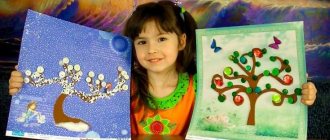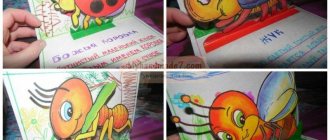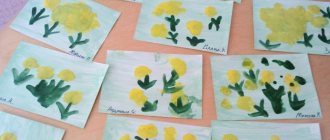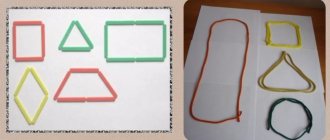5.3. Methods and techniques used in classes.
The main form of conducting classes is a game.
To maintain interest in LEGO construction classes, various forms and methods of conducting classes are used.
- conversations from which children learn information about modeling objects;
- work according to a model, - students complete the task in the sequence proposed by the teacher (according to the scheme), using certain skills;
— independent design to consolidate theoretical knowledge and implement your own unforgettable discoveries;
- collective work, where children can work in groups, pairs, all together.
When organizing work, it is necessary to try to combine play, work and learning, which will help ensure the unity of solving cognitive, practical and gaming problems. Game techniques, riddles, counting rhymes, tongue twisters, and thematic questions also help with creative work.
Goals and objectives of the program
The goal of the program is to create optimal conditions for the development of cognitive and creative activity of students through the development of LEGO construction.
Tasks:
- introduce preschoolers to the basic concepts and basic mechanics necessary for LEGO construction.
- contribute to the formation of knowledge about modes of transport and types of buildings;
- promote the formation of knowledge about counting, color, shape, proportion, symmetry, the concept of part and whole;
- create conditions for the development of children’s general cognitive abilities: attention, logical and imaginative thinking, memory, imagination.
- promote the development of fine motor skills and coordination of movements;
- promote the development of children's creative abilities.
- to promote the development of organizational and moral-volitional qualities of the individual: independence, discipline, development of patience and perseverance in achieving goals, etc.
5.1. Methodical:
The following teaching materials are used to implement the program:
- educational and thematic plan;
- methodological literature on Lego construction (list of references);
- resources of information networks on methods of conducting classes and selection of schemes for manufacturing products (list of references);
- summary of an open lesson for parents (Appendix 1)
- step-by-step construction diagrams (Appendix 2)
- illustrations of various buildings (Appendix 2)
- card index of finger games (Appendix 3)
- card index of physical minutes
- poems, riddles on class topics
Features of the organization of constructive-model activities of preschool children
MDOU IRMO "Mamonovsky combined kindergarten"
Topic:
“Features of organizing constructive-model activities of preschool children”
The Federal State Educational Standard for Preschool Education sets new guidelines for the development of the preschool education system and makes a number of changes to the organization of educational activities in preschool educational institutions.
“A child’s games with toys—the materials from which he constructs—are closest to normal human activity: from materials a person creates values and culture”
A.S.
Makarenko The term “design”
(from the Latin word construere) means bringing various objects, parts, elements into a certain relative position.
Under children's design
it is customary to mean the creation of different designs and models from different types of construction sets, the production of crafts from paper, cardboard, natural and waste materials
In accordance with the Federal State Educational Standard for Educational Education, “constructive-model” activities belong to the educational field “Artistic and Aesthetic Development”.
Design is a productive activity because it is aimed at obtaining a specific product.
The main purpose of the design:
Development of children's artistic creativity, interest in independent creative activity;
satisfying children's need for self-expression through construction from different materials. There are two types of design: technical and artistic. Technical
ones include:
- construction from building material (the parts of which have geometric shapes);
- constructing constructors from parts that have different fastening methods;
- construction from large-sized modular blocks.
In artistic
design include
- paper design
- construction from natural and waste materials.
There are many types
constructors: “Lego”, wooden, plastic, metal, magnetic, etc.
Nowadays, many different construction sets have been created for children, having a variety of shapes and types of fastening. A child can choose any one for his creativity.
But we must not forget about safety rules!
Construction sets containing small parts can only be given to the middle group under adult supervision (such as magnetic ones and various types of mosaics)!!!!
Artistic design: paper
- By combining different paper forms a huge variety of crafts are created.
- Despite its attractiveness, it complex activity
.. Therefore, the traditional method is based on a visual and detailed step-by-step explanation.
When designing from paper, you can use paper of different textures (depending on the tasks at hand).
Children learn:
- make markup using a template;
- create fun toys.
- and three-dimensional toys made using the origami technique.
Here you see crafts made using different techniques.
Made from natural material
- Natural material can be used as a building material for children's games, starting from the second junior group
. This is primarily sand, snow, water. From raw sand, children build a road, a house, using molds (sandboxes) - pies, Easter cakes
- In more older age
children freeze colored water, preparing colored ice flakes with which to decorate the area.
- The variety of natural materials (cones, acorns, branches, seeds, grass, etc.) and ease of processing allow it to be widely used in working with preschoolers
Beginning teachers can now take samples of crafts not only from manuals, but also from Internet resources.
Artistic design
from waste material
- You can use materials whose main requirement is safety: boxes of perfume, powder, matches, pieces of wire in colored winding, polystyrene foam, foam rubber, corks, etc. In fact, they are semi-finished products.
By connecting them with plasticine, glue or wire and adding various parts, you can get interesting toys - furniture, vehicles and other products.
Design forms:
Let us briefly consider all the forms of organization of teaching children's design known to us .
Design based on a model
is that children are offered samples of buildings made from parts of building materials and construction sets, paper crafts, etc. and, as a rule, show ways to reproduce them.
You can offer children types of work based on the model
:
- Independent design according to drawing
- Didactic game “Assemble a model from memory”
Design using simple drawings and visual diagrams
. Teaching children first to construct simple diagrams-drawings reflecting examples of buildings, and then, conversely, to practically create structures using simple diagrams-schemes.
Design by model
– Children are presented with a model as a model, in which the outline of its individual elements is hidden from the child. Children must reproduce this model from the building material they have. Thus, in this case, the child is offered a certain task, but is not given a way to solve it.
Design according to conditions
- fundamentally different in nature. It is as follows. Without giving children a sample of the building, drawings and methods of its construction, they only determine the conditions that the building must meet (for example, a house for a dog should be small, and for a horse – large).
Design
by design
is the independent creation of an image of a future structure and its embodiment in the material that the child has at his disposal.
Here we see plot construction by design, independent and collective (which can be performed by 2 or more people)
Constructive-model development in age groups
In the first younger group, the simplest construction .
By the age of three, children can already name what they will build. They learn to distinguish materials by shape and size, correctly name objects of building material (cube, brick), understand and correctly use words (big - small, high - low); follow verbal instructions. In games you should use figurative expressions, literary words, songs
Second junior group
. A more sustainable desire for independence appears. The main material for construction is construction material. Its sets are replenished with a new part - a bar. Children get acquainted with it, and it becomes clear how it differs from other parts (cube, brick, plate), in which position it is most stable: The teacher gradually complicates the task. Changing buildings in two ways: replacing some parts with others or building them up in height and length (low and high tower, short and long train).
The first buildings of their own design appear.
Middle group
. Four-year-old children acquire a fairly stable interest in construction games. The construction of crafts from paper, natural and waste materials appears.
In the older group
the ability to create buildings of different sizes and designs of the same object is formed.
We teach you how to build according to a drawing and how to independently select the necessary building materials.
We continue to develop the ability to work collectively, combine our crafts in accordance with a common plan, and agree on who will do what part of the work.
In the preparatory group
We teach you how to create structures united by a common theme (children’s playground, parking lot, etc.).
Create various models (buildings, planes, trains, etc.) according to a drawing, according to the teacher’s verbal instructions, according to one’s own ideas.
In accordance with the Program, it is at this age that children become familiar with a variety of plastic construction sets, as well as a wooden construction set, the parts of which are attached with pins. In fact, unfortunately, there are no such wooden construction sets in kindergartens yet!
Creation of three-dimensional toys using the origami technique,
Made from natural and waste materials.
Games contribute to the development of initial design skills:
Game "3 dice"
Each building has three parts.
Exercise:
according to the drawing, which shows the front view, create the given building. This game teaches you how to create the first buildings according to the scheme.
In the game “Match by Shape”
we train children in the ability to recognize and name three-dimensional shapes; relate geometric shapes to objects in the surrounding world.
Subject of design,
Just like planning of other types of activities, it should be determined in accordance with thematic calendar planning:
- During the thematic block “Vegetables and Fruits” you can plan the construction of a “Cellar for storing vegetables”
- block “Animals” - an enclosure for animals.
- Block My Homeland - Nerpinaria, etc.
We must remember that children really like to make something unusual. Children always perceive an unconventional approach to design with great interest.
But there are also problems:
- Insufficient equipment (there are no wooden construction sets with connections with fonts, soft modules are not available everywhere)
- It is necessary to conduct training seminars for teachers on design in preschool organizations in order to expand and deepen their knowledge on this topic.
- During design classes, development of sensory and thinking abilities
children.
- Construction has a great influence on the development of the child’s personality and volitional sphere.
- Implemented physical improvement
child.
- It's effective a means of aesthetic education.
Children develop artistic taste.
- Constructive activity is also a means moral education
preschoolers. In the process of this activity, important personality qualities are formed: hard work, independence, initiative, perseverance in achieving goals, organization.
I wish you creativity in your approach to developing children's design abilities!!!




